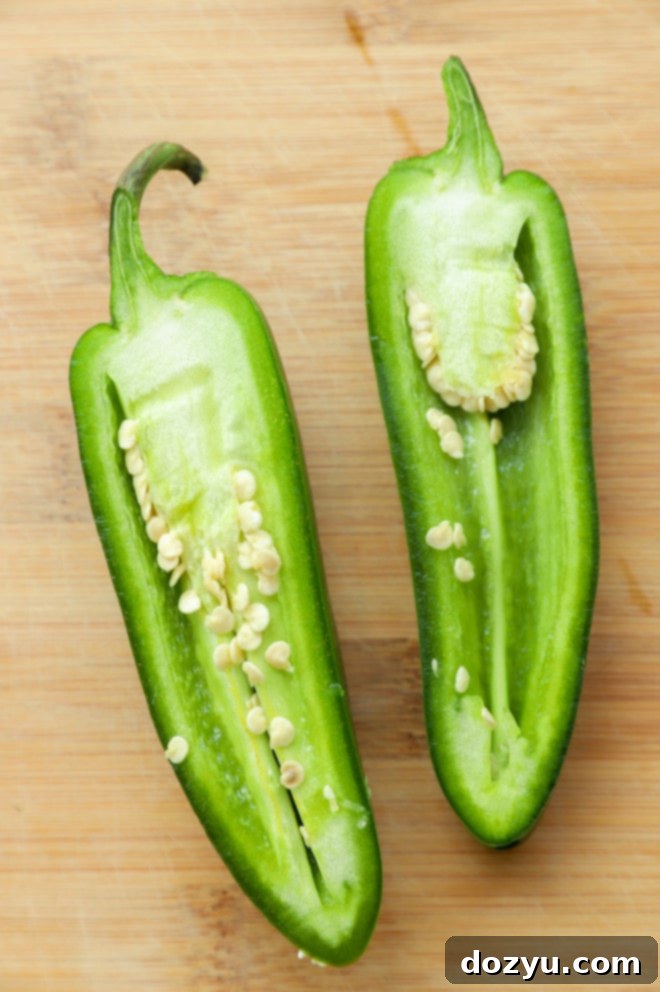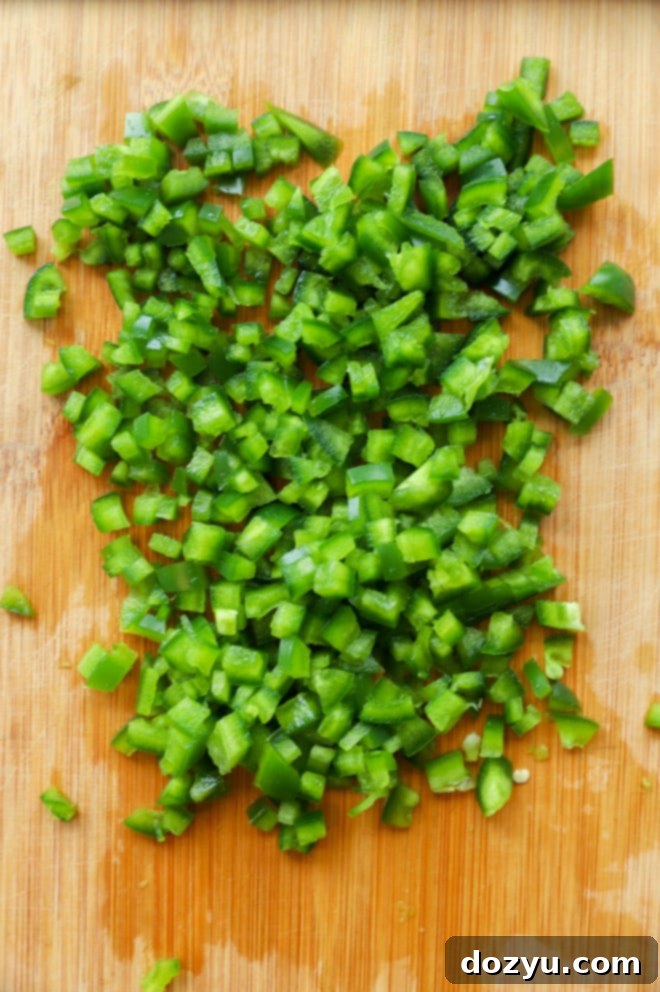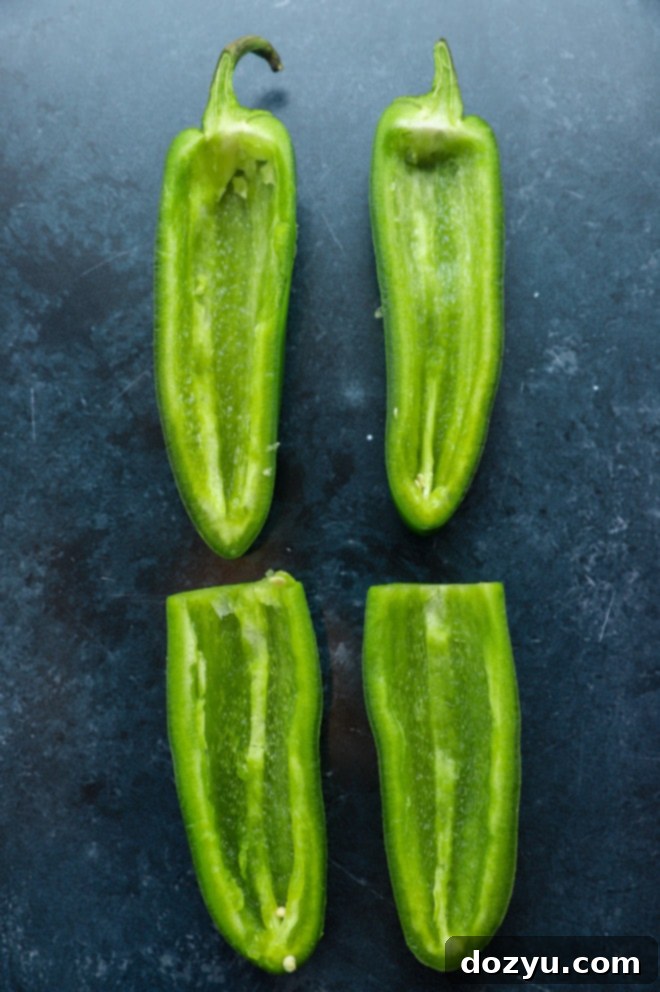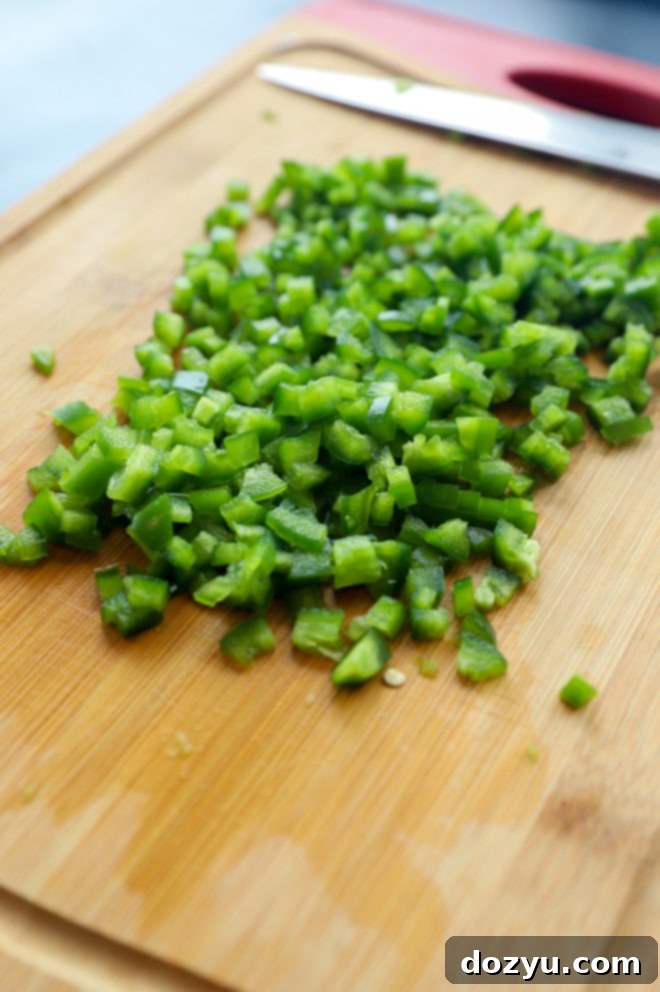How to Seed a Jalapeño: Your Ultimate Guide to Taming the Heat
Unlock the full potential of jalapeño peppers by learning how to seed them properly. This essential skill allows you to easily dice, chop, or transform them into beloved treats like jalapeño poppers. Dive into this comprehensive guide where we’ll explore everything from understanding their heat to our favorite recipes, ensuring your freshly seeded jalapeños elevate any meal.

Jalapeños are a culinary staple, celebrated for their vibrant flavor and characteristic kick. Whether you’re aiming for a subtle warmth or a fiery punch, these versatile chile peppers can transform an ordinary dish into something extraordinary. The world of hot peppers is vast, with an incredible array of heat levels and unique flavor profiles, but today, our focus is squarely on the ever-popular jalapeño.
An interesting fact that many home cooks find incredibly useful: **the larger the jalapeño, the spicier it typically is.** This simple yet effective tip empowers you to select the perfect pepper for your recipe, allowing you to control the heat with precision. It’s a game-changer for anyone who loves cooking with these zesty peppers.
The heat sensation we experience from chile peppers comes primarily from a compound called capsaicin. This natural chemical can irritate sensitive areas like your eyes, nose, and mouth, causing the familiar burning sensation. Understanding capsaicin is key to safely handling and preparing jalapeños, especially when seeding them to reduce their potency.


Table of Contents
Toggle
Introduction to Jalapeños: Understanding Their Flavor and Heat
Jalapeños are celebrated worldwide for their distinctive flavor that balances vibrant green notes with a pleasant, moderate heat. Originating from Mexico, these peppers are now a global favorite, finding their way into everything from Tex-Mex dishes and Asian stir-fries to refreshing cocktails and decadent desserts. Their popularity stems from their versatility; when properly prepared, they can add just the right amount of zest without overwhelming a dish.
Understanding a jalapeño isn’t just about its color or size, but also its potential heat. While generally considered a mild to medium hot pepper, a jalapeño’s spice level can vary significantly. This makes learning to seed them an invaluable skill, allowing you to customize the heat profile of any recipe to suit your palate or that of your guests.
The Science of Spice: Capsaicin and Scoville Units
The fiery sensation from jalapeños is due to capsaicinoids, a group of chemical compounds found predominantly in the white pith (placenta) and, to a lesser extent, the seeds of the pepper. Contrary to popular belief, the seeds themselves contain very little capsaicin; it’s the membrane that holds the vast majority of the heat. When you bite into a jalapeño, capsaicin binds to pain receptors in your mouth, sending signals to your brain that interpret this sensation as heat or burning.
The heat of peppers is measured using the Scoville Heat Unit (SHU) scale. Jalapeños typically range from 2,500 to 8,000 SHUs. To put that in perspective, a bell pepper has 0 SHU, while a habanero can reach over 100,000 SHUs. By carefully removing the pith and seeds, you can significantly reduce the capsaicin content, transforming a potentially very spicy pepper into a milder, more approachable ingredient. This process is key for those who love the flavor of jalapeños but prefer less intense heat.
Beyond their spicy kick, jalapeños offer several health benefits. They are a good source of Vitamin C, Vitamin A, and antioxidants, which can boost immunity and fight inflammation. Incorporating seeded jalapeños into your diet is a flavorful way to add nutrients without excessive heat.
Essential Tools for Seeding Jalapeños
Preparing jalapeño peppers efficiently requires just a few basic kitchen tools. You’ll need:
- Fresh Jalapeño Peppers: Of course! When selecting them, look for peppers that are firm, vibrant green, and free from soft spots or blemishes. Remember our earlier tip: larger jalapeños tend to be spicier.
- A Sharp Chef’s Knife or Paring Knife: A good quality, sharp knife is crucial for clean cuts and safe handling. It makes slicing through the pepper quick and effortless.
- A Sturdy Cutting Board: To protect your countertops and provide a stable surface for cutting.
- A Small Spoon or a Melon Baller: This is your primary tool for scooping out the seeds and membrane. A small spoon, like a teaspoon or demitasse spoon, works perfectly. A melon baller can also be very effective due to its curved edge.
- Disposable Gloves (Optional but Highly Recommended): As we’ll discuss, wearing gloves is the best way to prevent capsaicin burn on your hands.

Step-by-Step Guide: How to Seed a Jalapeño for Milder Heat
Preparation is Key: Washing Your Peppers
Before you begin, always wash your jalapeño peppers thoroughly under cool running water. This removes any dirt, pesticides, or other residues from the skin. Pat them dry with a clean paper towel.
The Initial Cut: Halving Your Jalapeños
The most common and effective way to seed a jalapeño is by cutting it lengthwise. Place the jalapeño on your cutting board and carefully slice it in half from the stem to the tip. This exposes the entire cavity, making it easy to access the seeds and membrane.
Note for Jalapeño Poppers: If your intention is to make jalapeño poppers, you might consider leaving the stem intact. This provides a natural “handle” for stuffing and serving, and many people prefer the rustic aesthetic of the stem-on popper. In this case, you would still slice the pepper lengthwise, but ensure the stem end remains attached to both halves or remove only enough to create a cavity.
Expert Tip: Removing Seeds and Pith Efficiently
Once your jalapeño is halved, you’ll see the white membrane (or pith) running down the inside, to which the seeds are attached. This pith contains most of the capsaicin, so its removal is crucial for reducing heat.
Take your spoon and gently scrape along the inside of each pepper half. Start from the bottom (tip) of the pepper and scoop upwards towards the stem end. This upward motion is often more effective, as it helps to gather the seeds and membrane together, preventing them from scattering and making it easier to remove them cleanly in one or two strokes. If you scoop downwards, seeds can sometimes get stuck or spread.
Will I get it all out in one motion? It takes practice! While you might not get every single seed and piece of membrane on your first try, especially with your first few peppers, you’ll improve with experience. Don’t stress if it takes a couple of passes to clean out the cavity thoroughly. The goal is to remove as much of the white pith and all the seeds as possible if you desire a truly mild flavor. If you prefer a bit more heat, you don’t need to be quite as meticulous with scraping out every last speck.
The cleaner you get the inside, the less spicy your jalapeño will be. This method ensures that you can enjoy the fresh, earthy flavor of the pepper without the overwhelming heat.
Post-Seeding Rinse (Optional)
After scraping, you can give the jalapeño halves a quick rinse under cold water to wash away any remaining stubborn seeds or membrane fragments. Pat them dry before proceeding with your recipe.

Safety First: Avoiding the Jalapeño Burn
Handling jalapeños, especially when seeding, can expose your skin to capsaicin, leading to an uncomfortable burning sensation. While some people have higher tolerance, it’s always best to err on the side of caution. Even for those accustomed to handling peppers, unexpected irritation can occur, particularly if you accidentally touch your eyes or other sensitive areas.
Protective Gear: Why Gloves Are Your Best Friend
The most effective way to prevent the dreaded “pepper hands” is to wear disposable plastic or latex gloves. These create a barrier between your skin and the capsaicin, ensuring you can handle, cut, and seed your jalapeños without any discomfort. This is particularly important if you have cuts or scrapes on your hands, or if you’re prone to skin sensitivities. Investing in a box of kitchen-safe disposable gloves is a small step that makes a huge difference in kitchen safety when dealing with spicy peppers.
Quick Relief: What to Do If You Get Burned
Even with the best intentions, accidents happen. If you forget your gloves or capsaicin manages to get on your skin, don’t panic! Water alone isn’t effective at washing away capsaicin, as it’s oil-soluble, not water-soluble. Here’s what to do:
- Use Oil: Rub a generous amount of olive oil, vegetable oil, or even milk (which contains casein, a protein that breaks down capsaicin) all over the affected skin. The oil helps to dissolve the capsaicin.
- Wash Thoroughly: After rubbing the oil for a minute or two, wash your hands vigorously with dish soap and warm water. The soap helps to emulsify the oil and wash away the capsaicin. You may need to repeat this process a couple of times.
- Dairy Products: For persistent burning, soaking your hands in milk or rubbing them with yogurt can provide additional relief.
- Avoid Touching Sensitive Areas: Until you’re absolutely sure your hands are capsaicin-free, avoid touching your eyes, nose, or any open cuts. If capsaicin gets into your eyes, flush them immediately with large amounts of cool water or milk. Seek medical attention if irritation persists.
While the burning sensation might not disappear instantly, these methods will significantly reduce it within a couple of hours. Remember, prevention with gloves is always the easiest route!
Maximizing Flavor: Tips for Using Seeded Jalapeños
Once your jalapeños are perfectly seeded, the culinary possibilities are endless. Removing the seeds and membrane not only reduces the heat but also allows the pepper’s fresh, green flavor to shine through, making it a versatile ingredient for a wide range of dishes.
Mastering the Dice: Different Cuts for Various Dishes
The way you cut your seeded jalapeño can impact both the texture and distribution of flavor in your dish. Here are a few common cuts:
- Fine Mince: For a subtle, even distribution of flavor without noticeable chunks, slice the seeded jalapeño halves into very thin strips, then cut crosswise into tiny pieces. Ideal for dressings, marinades, or finely textured salsas.
- Small Dice: For a more noticeable texture and slightly larger bursts of flavor, cut the halves into longer strips (julienne), then cut crosswise into small, uniform cubes (about 1/4 inch). Perfect for guacamole, chili, or scrambled eggs.
- Rings: If you’re using the jalapeño as a garnish or want a visually appealing slice, you can carefully slice whole, unseeded jalapeños into rings. For milder rings, you can carefully scoop out the seeds from each ring with a small spoon or the tip of a knife. These are great for topping nachos, pizzas, or sandwiches.
- Strips/Julienne: For stir-fries, fajitas, or certain salads, cut the seeded halves into thin, long strips.
Adjusting the Heat: Beyond Just Seeding
While seeding is the primary method for reducing heat, there are other considerations:
- Choose Wisely: As mentioned, smaller jalapeños tend to be milder. If you want minimal heat, pick the smallest peppers.
- Cooking Method: Cooking jalapeños (roasting, grilling, sautéing) can mellow their heat further compared to eating them raw. The heat dissipates somewhat through the cooking process.
- Quantity: Even with seeded peppers, the more you add, the more residual heat your dish will have. Start with a small amount and taste as you go.
- Pair with Dairy/Acid: If a dish turns out too spicy, dairy products (like sour cream, yogurt, or cheese) or acidic ingredients (lime juice, vinegar) can help to neutralize the capsaicin and balance the flavors.
Raw vs. Cooked Jalapeños: When to Use Which
Jalapeños can be enjoyed both raw and cooked, each method bringing out different characteristics of the pepper. Knowing when to use which is key to optimizing your dish’s flavor profile.
- Raw Jalapeños: When eaten raw, jalapeños retain their crisp texture, bright green flavor, and maximum heat (even when seeded). This makes them perfect for applications where you want a fresh, zesty bite and a direct kick. Think salsas, guacamole, salads, ceviche, or as a garnish for tacos and nachos. Remember, raw jalapeños, even seeded, will always be spicier than their cooked counterparts.
- Cooked Jalapeños: Cooking jalapeños, whether sautéing, roasting, grilling, or pickling, mellows their heat considerably and softens their texture. The cooking process breaks down some of the capsaicin, resulting in a milder, sweeter flavor profile. Cooked jalapeños are excellent in stir-fries, omelets, chilis, stews, roasted vegetable medleys, or incorporated into sauces and marinades. They offer depth of flavor without overpowering heat.
Storage Solutions: Keeping Your Jalapeños Fresh
Proper storage is essential to extend the life of your jalapeños and ensure they remain fresh and flavorful for your culinary endeavors.
Short-Term Storage: Refrigeration and Room Temperature
- Whole Jalapeño Peppers: Uncut, whole jalapeños can be stored at room temperature for about 3 to 5 days, ideally in a cool, dry place away from direct sunlight. For longer storage, refrigerate them. Place whole peppers in a loose plastic bag or a crisper drawer in your refrigerator. This method can keep them fresh for 1 to 2 weeks. Avoid washing them until you’re ready to use them, as excess moisture can accelerate spoilage.
- Seeded and Diced Jalapeños: Once you’ve seeded and diced your jalapeños, their shelf life decreases. Store them in an airtight container in the refrigerator. To absorb any excess moisture and keep them fresher for longer, you can place a paper towel at the bottom of the container. They will last for about 2 to 4 days when stored this way.
Long-Term Storage: Freezing Jalapeños
For even longer storage, freezing is an excellent option. Frozen jalapeños retain their flavor and heat well, though their texture will soften slightly after thawing, making them best suited for cooked dishes rather than raw applications. Here’s how to freeze them:
- Wash and Prepare: Wash your jalapeños thoroughly. Decide if you want to freeze them whole, sliced, or seeded and diced. For seeded and diced, follow the instructions above.
- Blanch (Optional but Recommended): For best results, especially with whole or sliced peppers, blanch them in boiling water for 2-3 minutes, then immediately transfer to an ice bath to stop the cooking. This helps preserve color and texture.
- Pat Dry: Ensure the peppers are completely dry before freezing to prevent ice crystals from forming.
- Flash Freeze: Arrange the jalapeños in a single layer on a baking sheet lined with parchment paper. Place the baking sheet in the freezer for 1-2 hours, or until the peppers are solid. This prevents them from sticking together.
- Store in Freezer Bags: Once flash-frozen, transfer the solid jalapeños to airtight freezer bags or containers. Remove as much air as possible to prevent freezer burn. Label with the date.
Frozen jalapeños can last for 6 to 9 months. You can typically use them directly from the freezer in cooked dishes without thawing.
Everyday Seasonal Cookbook
Discover the joy of cooking with the seasons! Our Everyday Seasonal Cookbook is packed with inspiring recipes, practical guides to seasonal produce, and creative ideas for every occasion. Elevate your home cooking by embracing fresh, seasonal ingredients.

How to Tell if Your Jalapeños Have Gone Bad
Recognizing the signs of spoilage in jalapeños is important to ensure you’re always cooking with the freshest ingredients. Here’s what to look for:
- Wrinkling Skin: The first sign that a jalapeño is past its prime is often wrinkled or shriveled skin. This indicates moisture loss. While still generally safe to eat at this stage, the pepper’s crispness and vibrant flavor will be diminished. It’s best to use them up quickly.
- Soft Spots or Sliminess: If parts of the pepper become soft, mushy, or feel slimy to the touch, it’s a clear indication that it’s going bad. These areas may also show discoloration.
- Discoloration: Beyond the natural ripening from green to red, any unusual dark spots, black patches, or significant yellowing that isn’t part of the pepper’s natural aging process can indicate spoilage.
- Mold: Any fuzzy growth, white or otherwise, means the jalapeño should be discarded immediately.
- Unpleasant Odor: A fresh jalapeño has a characteristic earthy and slightly pungent aroma. If it starts to emit a foul, sour, or musty smell, it’s time to throw it out.
Always trust your senses. If a jalapeño looks or smells off, it’s safer to discard it to prevent any potential foodborne illness.
Culinary Inspiration: Diverse Ways to Use Seeded Jalapeños
Once you’ve mastered the art of seeding jalapeños, a world of culinary possibilities opens up. The reduced heat means you can truly appreciate their fresh, green flavor and versatile texture. Here are just a few ideas to get your inspiration flowing:
- Jalapeño Poppers: This classic appetizer is a perfect use for seeded jalapeños. Stuff them with cream cheese, cheddar, bacon, or a combination, then bake or air fry for a crispy, creamy, and mildly spicy treat.
- Salsas and Dips: Diced seeded jalapeños are a fundamental ingredient in fresh salsas, guacamole, and creamy dips. They add a bright flavor without overwhelming heat.
- Salads: Thinly sliced seeded jalapeño rings can add a delightful crunch and subtle kick to green salads, fruit salads, or grain bowls.
- Marinades and Dressings: Finely minced seeded jalapeños infuse marinades for chicken, fish, or beef with a fresh, herbaceous note. They can also be blended into vinaigrettes for a vibrant dressing.
- Breakfast Dishes: Add diced seeded jalapeños to scrambled eggs, omelets, or breakfast burritos for a flavorful morning boost.
- Baked Goods: Surprising as it may seem, seeded jalapeños can add an intriguing savory element to cornbread, biscuits, or even savory muffins.
- Infused Oils and Vinegars: For a unique culinary gift or a special ingredient in your pantry, infuse olive oil or vinegar with seeded jalapeño slices.
- Cocktails: Muddled seeded jalapeños can add a sophisticated, savory, and very mild heat to margaritas or other cocktails.
The options are truly endless! Seeding jalapeños makes them accessible for everyone, allowing you to incorporate their fantastic flavor into almost any dish.
Our Top Jalapeño Recipes to Try
Now that you’re a pro at seeding jalapeños, it’s time to put your skills to the test! Here are some of our absolute favorite recipes that truly highlight the incredible flavor of these versatile peppers:
- Want something warm, cheesy, and perfectly spicy? Our bacon jalapeño artichoke dip spices up any appetizer spread with an irresistible kick.
- Elevate your burger experience to new heights by making our crunchy and spicy salsa jalapeño crunch burger! It’s an explosion of flavors and textures.
- If you are looking for epic jalapeño popper recipes, you absolutely have to try our air fryer buffalo jalapeño poppers for a crispy, spicy, and cheesy delight, or our gourmet goat cheese bacon wrapped jalapeños for a truly decadent treat.
- One of the most popular recipes of all time on Cake ‘n Knife is this unique recipe for jalapeño avocado cream cheese wontons. They’re crunchy, creamy, and boast just the right touch of heat!
- Indulge in our gooey, spicy jalapeño popper dip – it’s absolutely perfect for feeding a crowd. Plus, you can easily prepare it ahead of time and bake it right before your next gathering for effortless entertaining.

Finally, if you found this guide on how to seed jalapeños helpful, please consider giving this how-to a rating or leaving a comment below! We’d absolutely love to hear how you used your freshly seeded jalapeños and any creative dishes you whipped up. We make an effort to respond to every single comment and are always here to answer any questions you might have.
Oh, and be sure to tag us on Instagram if you share your culinary creations! Seeing these recipes come to life in your homes truly makes our day – it’s our favorite thing to look through all your amazing photos. Your engagement and creativity mean the world to us!

How to Seed a Jalapeño
Equipment
-
Wusthof Knife Set
-
Shun Chef’s Knife
-
Utility Cutting Board
-
Spoon (or melon baller)
-
Disposable gloves (optional)
Ingredients
- Fresh Jalapeño peppers (as many as needed for your recipe)
Instructions
-
Prepare: Wash your jalapeño peppers thoroughly and pat them dry. For safety, consider wearing disposable gloves.
-
Cut: Slice each jalapeño in half lengthwise, from stem to tip, exposing the seeds and white membrane (pith). If making poppers, you can carefully remove only the top and inner membrane while keeping the stem intact for handling.
-
Seed: Using a small spoon (or melon baller), gently scrape out the seeds and the white membrane from the bottom of each pepper half upwards towards the stem. This motion helps to efficiently remove most of the spicy components. Be thorough if you desire minimal heat.
-
Rinse (Optional): For extra assurance, give the seeded pepper halves a quick rinse under cold water to wash away any lingering seeds, then pat dry.
-
Use as Desired: Your jalapeños are now ready to be diced, minced, stuffed for poppers, or used whole in your favorite recipes, offering a milder, flavorful experience!
Video
